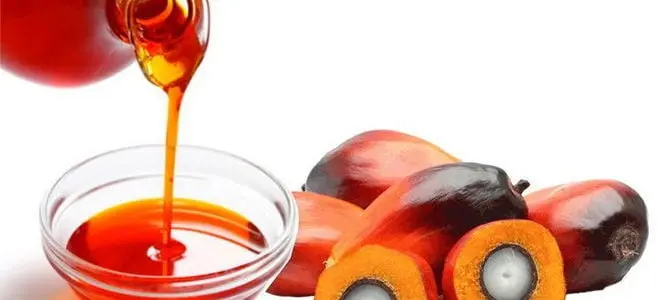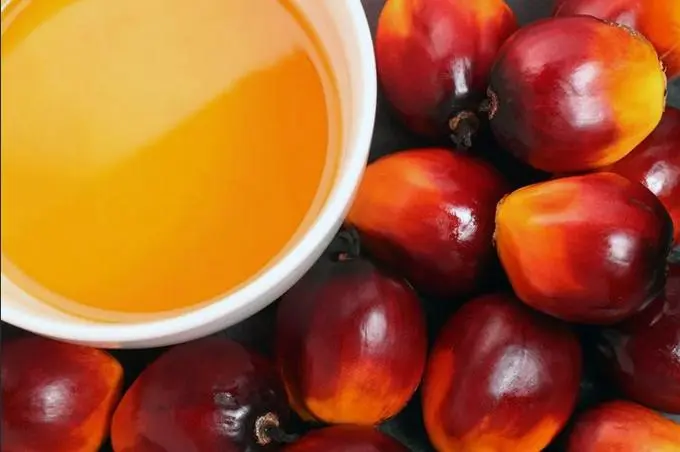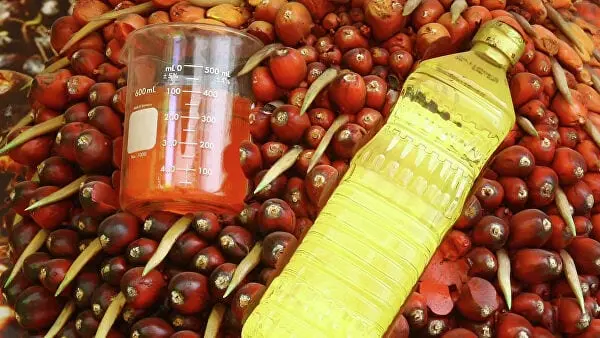Contents
- Description
- Composition
- What foods use palm oil
- The harm of palm oil
- The benefits of palm oil
- 6 myths about palm oil
- 1. It is a powerful carcinogen, and developed countries have long refused to import it for food use
- 2. Rich countries are supplied with “one” palm oil, and poor countries with “another”
- 3. The world is abandoning the “palm tree” and switching to sunflower oil
- 4. Palm oil is deliberately not listed in foods
- 5. Banning the “palm tree” will not affect the economy in any way, it will only reduce the excess profits for producers
- 6. It is inferior in quality to other oils
Description
Palm oil, around which there are so many rumors and conflicting opinions, is made from the fleshy fruits of the oil palms. The crude product is also called red because of its terracotta hue.
The main source of palm oil is the Elaeis guineensis tree, which grows in West and South West Africa. The locals ate its fruits long before the oil was produced from them on a global scale. A similar oil palm, known as Elaeis oleifera, is found in South America, but is rarely grown commercially.
However, a hybrid of the two plants is sometimes used in the production of palm oil. More than 80% of today’s product is prepared in Malaysia and Indonesia, mainly for imports around the world.

Composition
Palm oil is 100% fat. At the same time, it contains 50% of saturated acids, 40% of monounsaturated acids, and 10% of polyunsaturated acids.
One tablespoon of palm oil contains:
- 114 calories;
- 14 g fat;
- 5 g monounsaturated fat;
- 1.5 g polyunsaturated fat;
- 11% of the daily value for vitamin E.
The main fats of palm oil are palmitic acid, in addition to it, it also contains oleic, linoleic and stearic acids. The reddish-yellow pigment comes from carotenoids, antioxidants like beta-carotene.
The body converts it into vitamin A.
Like coconut oil, palm oil hardens at room temperature, but melts at 24 degrees, while the former at 35 degrees. This indicates a different composition of fatty acids in two types of plant products.
What foods use palm oil

Palm oil is popular with growers due to its relatively low price. It accounts for a third of the world’s vegetable fat production. Its zesty and earthy flavor, like pumpkin or carrot, pairs well with peanut butter and chocolate.
In addition to candy bars and candy bars, palm oil is added to cream, margarine, bread, cookies, muffins, canned food and baby food. Fat is found in some non-food products such as toothpaste, soaps, body lotions, and hair conditioners.
In addition, it can be used to create biodiesel fuel, which serves as an alternative source of energy [4]. Palm oil is purchased by the largest food manufacturers (according to WWF’s 2020 report):
- Unilever (1.04 million tonnes);
- PepsiCo (0.5 million tonnes);
- Nestle (0.43 million tons);
- Colgate-Palmolive (0.138 million tonnes);
- McDonald’s (0.09 million tons).
The harm of palm oil

In the 80s, the product began to be replaced with trans fats, fearing a possible risk to the heart. Many studies report conflicting results on the effects of palm oil on the body.
Scientists have conducted experiments with women who have been diagnosed with high cholesterol levels. With the use of palm oil, this figure became even higher, namely, it is associated with diseases of the cardiovascular system.
Interestingly, many other vegetable fats can lower cholesterol, even when combined with palm oil.
In 2019, WHO experts published a report mentioning articles on the benefits of palm oil. However, upon closer examination, it turned out that four of the nine articles mentioned in the report were written by employees of the Malaysian Ministry of Agriculture, who are responsible for the development of the industry.
One of numerous studies has shown that reheating hardened palm oil makes it dangerous. Continuous use of this product leads to the formation of deposits in the arteries due to a decrease in the antioxidant properties of vegetable fat. At the same time, adding fresh oil to food did not lead to such consequences.
The benefits of palm oil

The product may provide health benefits. Palm oil improves cognitive function and has a positive effect on the brain. It is used to prevent vitamin A deficiency and is an excellent source of tocotrienols, forms of vitamin E with strong antioxidant properties.
Research shows that these substances help protect the body’s polyunsaturated fats from breakdown, slow the progression of dementia, reduce the risk of stroke, and prevent the growth of cerebral cortex lesions.
During the experiment, scientists divided 120 people into two groups, one of which was given a placebo, and the other – tocotrienols from palm oil. As a result, the former showed an increase in brain lesions, while the indicators of the latter remained stable.
A large analysis of 50 studies found total and LDL cholesterol levels were lower in people who ate a diet supplemented with palm oil.
6 myths about palm oil
1. It is a powerful carcinogen, and developed countries have long refused to import it for food use
This is not true and is largely populism. They discard only certain fractions, but not the palm oil itself. This is vegetable fat, which is on an equal footing with sunflower, rapeseed or soybean oils. They all have their pros and cons. But palm oil is unique.
Firstly, it is harvested 3 times a year. The tree itself grows for 25 years. In the 5th year after disembarkation, it begins to bear fruit. In the future, the yield decreases and stops at the age of 17-20 years, after 25 years the tree is changed. Accordingly, the cost of growing a palm tree is several times less than that of other oilseeds.
As for carcinogens, rapeseed oil is perhaps even more toxic than sunflower oil. For example, you can fry in sunflower oil only 2 times, otherwise, with further use, it becomes a carcinogen. Palm can be fried 8 times.
The danger depends on how conscientious the manufacturer is and how he uses the oil. Although it is not in his interests to save on quality, since the taste of the “old” oil will spoil the taste of the product. The man opened the pack, tried it and will never buy again.
2. Rich countries are supplied with “one” palm oil, and poor countries with “another”
No, the whole question is about cleaning quality. And this is incoming control, depending on each state. Ukraine receives standard palm oil, which is used all over the world. In world production, palm oil is 50% of edible fats, sunflower oil – 7% of fats. They say that “palm” is not consumed in Europe, but the indicators show that its consumption has increased in the EU over the past 5 years.

Again, to the question of cleaning. Let’s compare with sunflower oil. When it is produced, the output is oil, fusse, cake and husk. If you give a person a fooz, then, of course, he will not be very pleasant. Likewise with palm oil. In general, the word “palm oil” means the whole complex: there is oil for human consumption, there are fractions from palm oil for technical applications. We at Delta Wilmar CIS deal only with edible fat.
If we talk about our enterprise, then we release a product that is certified for all safety indicators, our production has also been certified. We analyze our products in European laboratories. All the filling of the enterprise is only from European manufacturers (Belgium, Germany, Switzerland). Everything is automated. After the installation of equipment, we undergo annual accreditation and certification, just like European companies.
3. The world is abandoning the “palm tree” and switching to sunflower oil
Sunflower oil is a trans fat. Trans fats are bad blood, strokes, heart attacks, and everything else. Accordingly, it is used when frying, and in all other cases it is replaced with palm.
4. Palm oil is deliberately not listed in foods
I can say with confidence that all confectionery manufacturers in Ukraine indicate that their products include palm oil. If desired, the manufacturer will always tell you about which fats are included in the recipe. This is completely open information. If the manufacturer of dairy products does not indicate, then this is another story.
This is a crime and the responsibility of the manufacturer that produces such products. He does not mix in a bad product, he just makes money, because oil, relatively speaking, costs UAH 40, and oil from vegetable fats of different recipes will cost UAH 20. But the manufacturer sells at 40. Accordingly, this is profit and deception of buyers.
Nobody falsifies the “palm tree”, because it cannot be forged. There is falsification in dairy products when the manufacturer does not indicate that vegetable (palm or sunflower) fats are used. This is the only way to mislead the buyer.

5. Banning the “palm tree” will not affect the economy in any way, it will only reduce the excess profits for producers
All confectionery factories will immediately be closed, which in a couple of months will have to switch to rapeseed, soybeans, and hydrogenated sunflower. In fact, they will lose export, which requires that the product does not contain trans fats. When produced with hydrogenated sunflower oil, the formulation will contain trans fats. So the export will definitely disappear.
6. It is inferior in quality to other oils
Palm oil is widely used in confectionery and dairy products. Today, there is a lot of talk about whether it is useful or harmful, but all over the world, at the legislative level, there is an approval of standards for the content of trans fatty acids in the finished product.
Trans fatty acid isomers are formed in vegetable fat during hydrogenation, a process by which liquid fat is hardened into solid.
Solid fat is needed to make margarine, fat for waffle fillings, cookies, etc. In order to obtain solid fat from sunflower, rapeseed, soybean oil, the fat-and-oil industry undergoes a hydrogenation process and obtains fat with a certain hardness.
This is a fat in which there are already at least 35% trans isomers. Natural fat after extraction does not contain trans isomers (neither palm oil, nor sunflower oil). But at the same time, the consistency of palm oil is already such that we can use it as fat for fillings, etc.
That is, no additional processing is required. Because of this, palm oil does not contain trans isomers. Therefore, here it wins over other vegetable fats that are familiar to us.










Halkee. Laga helaya.wallaal salidda timirta gudaha magaalooyinka somalida